- Small Dog Place Home
- A to Z Breed List
- Pomeranians
Pomeranians: Tiny Spitz Dogs
by Janice Jones |Last Updated 04-10-2023
Pomeranians, Poms, Pom-Pom or just puffball, whatever you call these little cuties, everyone knows the name and the adorable face that accompanies that face. These little guys are stereotypical small, yappy, very energetic, but also a great pet to its owners and family.
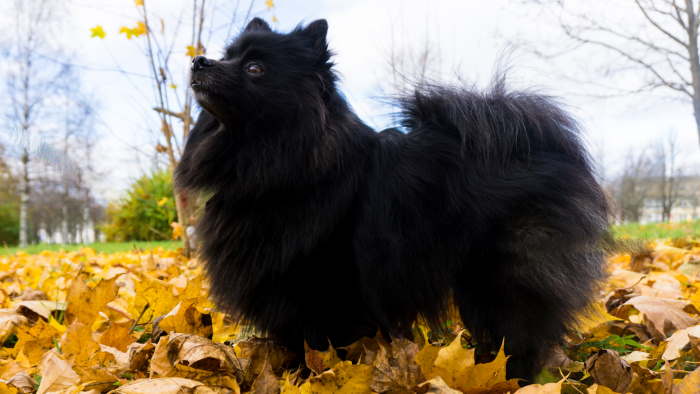
These are very energetic and athletic dogs that excel at many dog sports including agility and obedience. If you cannot keep up with the energy of the Pomeranian, this dog may not be for you.
Poms are basically the epitome of a big dog personality in a little dog. They have a ton of personality and demand attention and pampering. Even though they are small dogs, they are also very sturdy. Pomeranians are the type of dog that loves to please others.
They cannot get enough attention and affection from their owners. Although these dogs are pretty athletic and energetic, they do not need an excessive amount of exercise.
That is, unless they are being trained for any type of dog sport or agility type event. Other than that, they just need to be loved, like any other dog.
Related: 13 Pomeranian Facts You Might Not Know
| Traits | Rating |
|---|---|
| Playfulness | |
| Affection Level | |
| Friendliness Towards Strangers | |
| Good with Children | |
| Good with Other Dogs | |
| Good for First Time Owners | |
| Exercise Needed | |
| Ease of Training | |
| Watch Dog Ability | |
| Grooming Requirements | |
| Shedding | |
| Cold Tolerant | |
| Heat Tolerant |
Dog Breed Ratings Got You a Little Confused?
Here's a little help in understanding them
- Playfulness: Most Playful = 5 Least Playful = 1
- Affection: Most Affectionate = 5 Least Affectionate = 1
- Friendliness Towards Strangers: Most Friendly = 5 Least = 1
- Good With Children: Great= 5 Not Good with Children = 1
- Good With Dogs: Great = 5 Not Good Around Dogs = 1
- Good With First Time Owners: Fine=5 Not Appropriate = 1
- Exercise Required: Extensive Daily Exercise = 1 Minimal = 1
- Ease of Training: Very Easy = 5 Difficult = 1
- Watch Dog: Excellent Watch Dog = 5 Minimal = 1
- Grooming: Time Consuming = 5 Minimal = 1
- Shedding: Heavy Shedder = 5 Minimal = 1
- Cold Tolerance: Well Tolerated = 5 Poor Tolerance = 1
- Heat Tolerance: Well Tolerated = 5 Poor Tolerance = 1
Quick Facts
Other Names Used: Pom, Pom-Pom
Affiliation: Toy group; AKC recognized in 1888
Size
Height: 7-12 inches
Weight: 4-6 pounds
Coat Type: Long, thick double coat
Colors: Gray- shaded, tan, black, white, orange, and brown; Merle is a newer color being produced by breeders
Country of Origin: Poland and Germany
Activity Level: Moderate
Life Expectancy: Approximately 15 years
Good with Children: They are not recommended for families with small children because of their delicate and fragile frame, but they will get along great with kids under close supervision
Good with Other Pets: If raised and socialized appropriately, Poms are good with other dogs and pets
History
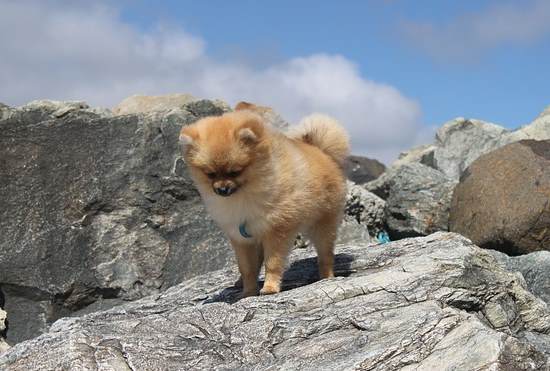
Pomeranians have quite the history, and it is actually said and known to believe that Poms were one of only 3 canines to survive the sinking of the Titanic.
Others say that Michael Angelo painted the 16th chapel with a Pomeranian right by his side. Contrary to belief, these small furry friends were not all that small once. They are now considered the smallest member of the Spitz family.
The average Pomeranian today weighs anywhere from four to six pounds, but they once weighed seven times that size. Older Pomeranians were said to have weighed thirty pounds and were solid white.
They were bred by England’s Queen Victoria, and in the late 1800s, Queen Vic established her own kennel and began importing smaller Poms of all colors and created her perfect little lap dog that we all know and love today.
Pomeranians are decedents of sled dogs from Ice and Lapland. Their ancestors include the Alaskan malamute, the Samoyed, Siberian husky, and Khase-hand. Poms are essentially just a mini version of those dogs.
Personality/Temperament
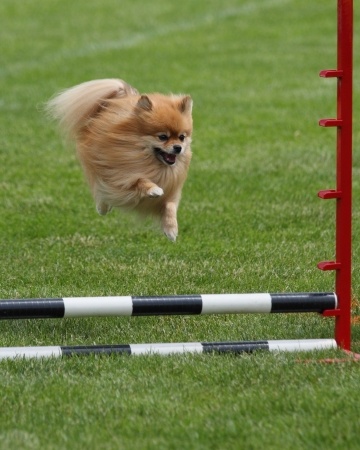
Even if you don’t know much about Pomeranians, everyone pretty much knows that they are very energetic, lively, bouncy dogs that can tend to have a large voice to them.
Pomeranians are extremely happy-go-lucky dogs that crave human companionship.
They are great lap dogs and live to please. Focusing their energy is a huge component of owning a Pom.
If you don’t, then they can be a bit unruly. Also starting socializing and working on barking as early as possible is highly recommended.
People think the Pom is a very yappy, annoying dog, but true Pomeranian loves know better. It really all depends on how early you start working on training and socialization.
Poms are not recommended for families with very small children due to the fragile frame that they have.
These little guys do not demand a ton of physical activity, but will need a daily walk. If not a walk, at least a good romp in a fenced in yard will help release some of that energy.
The time that they spend playing will take care of most of their exercise, but you need to keep them healthy and in shape. Lack of exercise can lead to behavior problems.
Poms have the tendency to overheat in their thick double coat, so do not let them overwork themselves. Supervision while playing outside in the heat is crucial. Pomeranians don't do well in hot weather.
Their beautiful dense plush coat heats up quickly so they need to be kept out of the heat, especially that of a locked car.
They are also very adaptable and can pretty much adapt to most living conditions. These dogs can be great apartment dwellers. They make excellent watchdogs, and with the proper teaching of when barking is allowed, will be a perfect watchdog for you.
The main thing that the Pomeranian needs is love and affection, and they will be your furry friend for life.
Housetraining is often a problem in small breed dogs and the Pomeranian is no exception. Owners often report that their Pom just doesn’t like a rainy day, and this stubbornness can extend to other weather too. Poms can be taught to use an indoor potty system such as wee wee pads or paper training.
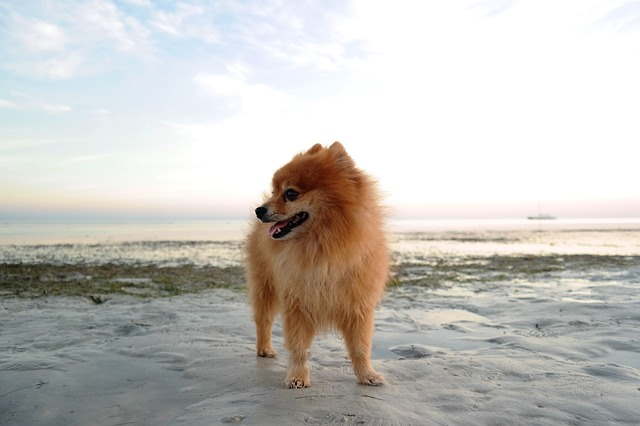
Teacup Pomeranians
You might have seen these advertised as being ultra-tiny versions of the standard Pomeranian, often weighing in at no more than one or two pounds.
Don’t be misled into thinking this is a different breed or something extra special in some way. Most reputable breeders would not deliberately breed smaller than the breed standard so beware of anyone trying to sell a “teacup” version of any breed, especially the Pomeranian.
Grooming
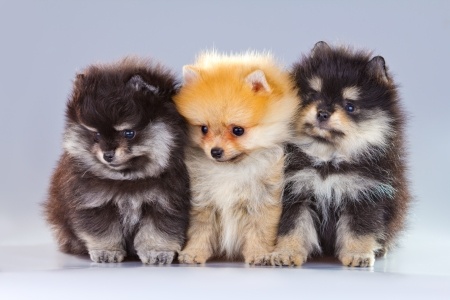
Grooming for the Pomeranian can be a bit tricky because of their thick, long, double coat.
The inner coat is soft and fine and the outer coat is thick and harsh. One down side to owning a Pom is that they are heavy and constant shedders.
Daily brushing with a high quality slicker brush is a must to deal with all of the shedding and to keep mats from forming. Poms should not be bathed until a thorough brushing is done. It is also highly recommended to take your pup to a professional groomer every four to six weeks to keep the shedding and coat in general in check.
Other than brushing, the rest of grooming falls into the category of must dos for all dogs: nail clips, anal glands, ears and eye cleaning. Did we mention brushing teeth? That too!
Health Concerns
Pomeranians are generally healthy and have a long life span (12-16 years); some of the issues are minor and some are more serious. Do not let the list below frighten you into removing the Pomeranian from your short list of possible perfect breeds for you.
Luxating Patella
An inherited condition where the knee slips in and out of place when bent.
Dental Issues
All dogs are susceptible to dental problems but some breeds seem to build up more tarter and plaque.
Tracheal Collapse
When the rings making up the trachea begin to flatten or collapse, breathing becomes more difficult.
Skin and Coat Problems
Coat loss problems also called
Black skin disease, Severe Hair Loss Syndrome or Alopecia X can be a problem in
Pomeranians. Hair loss can be caused by
hypothyroidism, Cushing’s disease, eczema, parasites or allergies.
Heart Problems
The most common heart problems in the Pomerian includes heart murmurs, enlarged heart and mitral valve prolapse.
Eye Problems: Entropion
A congenital condition where the eyelids roll inward. It can also occur due to injury or a long standing eye lid infection that causes scaring.
Legg-Perthes Disease
Seizures or Idiopathic Epilepsy
A reoccurring seizure disorder, idiopathic epilepsy does not have a known cause.
Pin for Future Reference
Pros
- Very adaptable
- Love to please people
- Can be great watchdogs
- Highly intelligent
- Proud and loyal
- Great lapdogs and overall companions
Cons
- Heavy and constant shedders
- Can be yappy if not properly trained
- Tend to be overprotective to objects
- Very fragile and can be hard with young children and toddlers
- Problems with their knees, teeth, and gums
- Grooming is quite the task
References and Gifts for the Pom Lover
Breed Club & Rescue
Breed Club:
American Pomeranian Club, Inc.
http://www.AmericanPomeranianClub.org/
Breed Rescue:
About Janice (author and voice behind this site)
Having lived with dogs and cats most of her life, Janice served as a veterinary technician for ten years in Maryland and twelve years as a Shih Tzu dog breeder in Ohio.
Her education includes undergraduate degrees in Psychology with a minor in biology, Early Childhood Education, and Nursing, and a master's in Mental Health Counseling.
She is a lifelong learner, a dog lover, and passionate about the welfare of animals. Her favorite breed for over 50 years has been the Shih Tzu, but she has also lived with Poodles, Maltese, Yorkshire Terriers, Beagles, English Bulldogs, Carin Terriers, and a Cocker Spaniel.
When not writing, reading, and researching dog-related topics, she likes to spend time with her eight Shih Tzu dogs, husband, and family, as well as knitting and crocheting. She is also the voice behind Miracle Shih Tzu and Smart-Knit-Crocheting
Does This Article Deserve Your Thumbs Up?
We always appreciate your support and encouragement. Your thumbs up means so much to us. Please like this article.
If you find this page or any page on Small Dog Place Helpful, or useful in anyway, I'd love it if you would click the small heart found on the bottom right of each page.
You can also share or bookmark this page -- just click on the:

Free Monthly Newsletter
Sign Up for Our Free Newsletter and get our Free Gift to You.
my E-book, The Top 10 Mistakes People Make When Choosing a Dog (and how to avoid them)





